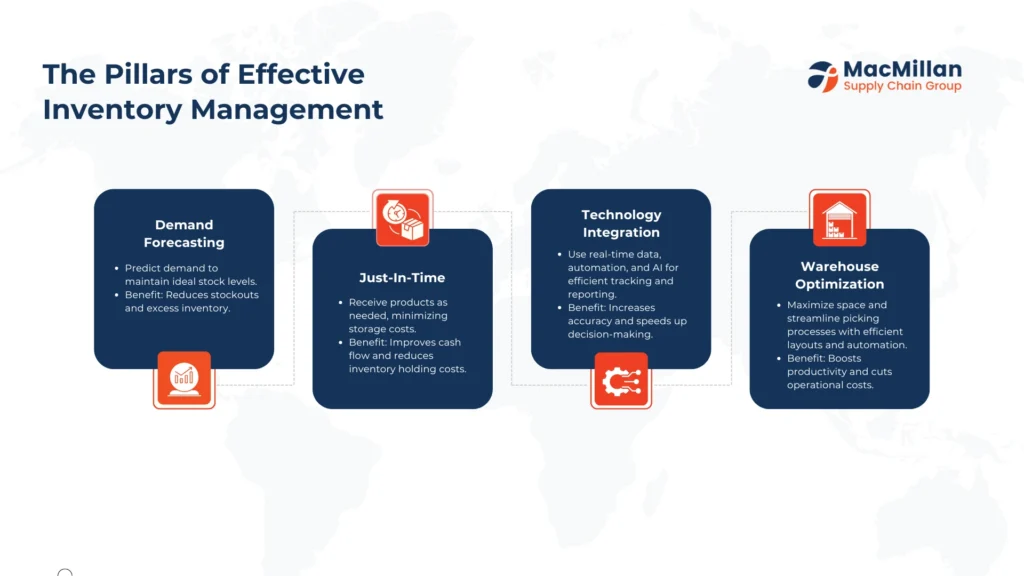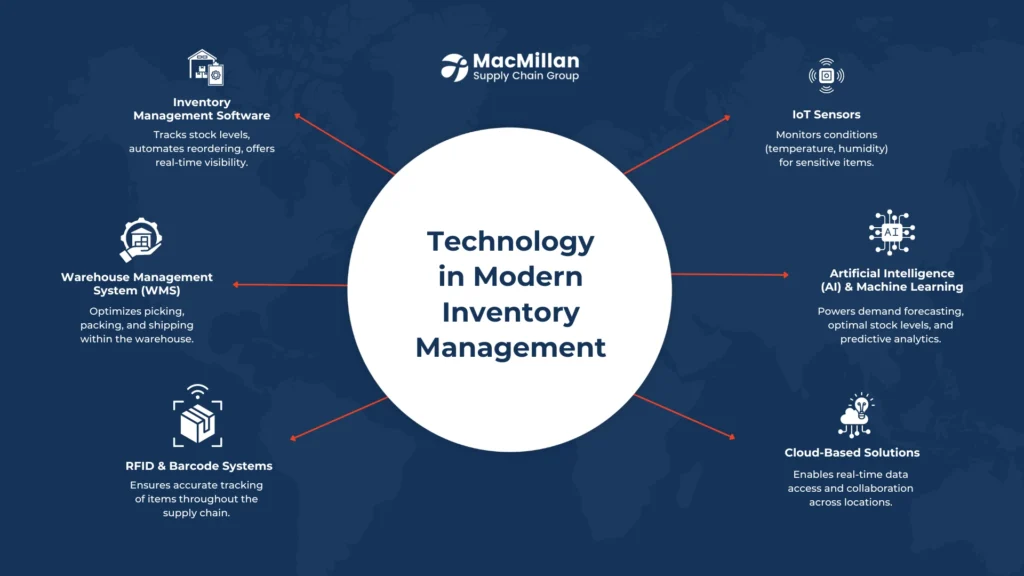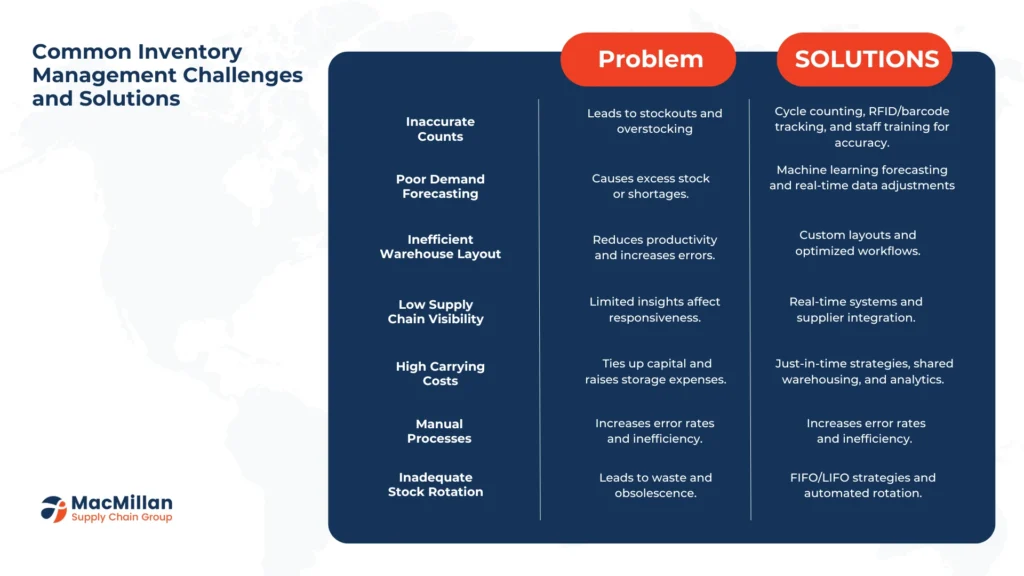A quick summary and overview
Effective inventory management is crucial for supply chain success, impacting everything from operational costs to customer satisfaction. This article explores key strategies for optimizing inventory control, including demand forecasting, just-in-time inventory, and leveraging technology. We’ll discuss common challenges businesses face and how to overcome them. Additionally, we’ll highlight how MacMillan Supply Chain Group’s expertise can help companies implement these strategies, improve warehouse efficiency, and achieve better overall supply chain performance. Whether you’re a small business owner or a logistics manager in a large corporation, this guide will provide valuable insights to enhance your inventory management practices.

An introduction
In today’s fast-paced business environment, efficient inventory management is more critical than ever. It’s the backbone of a well-functioning supply chain, directly influencing a company’s bottom line and customer satisfaction levels. However, striking the perfect balance between having enough stock to meet demand and avoiding excess inventory is a complex challenge. This article delves into the world of inventory management, exploring strategies that can help businesses of all sizes optimize their stock control processes. From leveraging cutting-edge technology to implementing tried-and-true methodologies, we’ll cover a range of approaches to help you streamline your inventory management. Moreover, we’ll discuss how partnering with a third-party logistics provider like MacMillan Supply Chain Group can provide the expertise and resources needed to take your inventory management to the next level.
Understanding Demand Forecasting
Demand forecasting is a crucial component of effective inventory management. It involves predicting future customer demand for products or services, allowing businesses to maintain optimal inventory levels. Accurate forecasting helps prevent stockouts and overstock situations, both of which can be costly.
To implement effective demand forecasting:
- Analyze historical data: Look at past sales trends, seasonality, and external factors that influenced demand.
- Utilize statistical models: Employ time series analysis, regression models, or machine learning algorithms to predict future demand.
- Consider market trends: Stay informed about industry developments, consumer behavior changes, and economic factors that could impact demand.
- Incorporate real-time data: Use point-of-sale systems and inventory management software to capture and analyze current sales data.
- Collaborate with suppliers and customers: Share information to improve forecast accuracy and align inventory levels across the supply chain.
- Regularly review and adjust forecasts: Monitor the accuracy of your predictions and refine your methods accordingly.
By mastering demand forecasting, businesses can optimize their inventory levels, reduce carrying costs, and improve customer satisfaction through better product availability. MacMillan Supply Chain Group offers advanced forecasting tools and expertise to help companies implement robust demand prediction systems, ensuring they stay ahead of market fluctuations and customer needs.
Implementing Just-in-Time (JIT) Inventory
Just-in-Time (JIT) inventory is a strategy that aims to reduce inventory holding costs by receiving goods only as they are needed in the production process. This approach can significantly improve efficiency and reduce waste in the supply chain.
Key aspects of implementing JIT inventory include:
- Strong supplier relationships: Develop partnerships with reliable suppliers who can deliver quality products on short notice.
- Efficient communication systems: Implement real-time information sharing between all parts of the supply chain to coordinate deliveries precisely.
- Streamlined production processes: Optimize manufacturing or assembly lines to reduce lead times and increase flexibility.
- Accurate demand forecasting: Use robust forecasting methods to predict inventory needs with precision.
- Continuous monitoring and adjustment: Regularly assess the effectiveness of the JIT system and make necessary adjustments.
- Risk management: Develop contingency plans for potential supply disruptions or unexpected demand spikes.
While JIT inventory can lead to significant cost savings and efficiency improvements, it requires careful planning and execution. The strategy may not be suitable for all businesses or product lines, particularly those with highly unpredictable demand or long lead times.
MacMillan Supply Chain Group can help businesses assess whether JIT inventory is right for them and assist in implementing the strategy effectively. Our expertise in supply chain optimization can help you balance the benefits of reduced inventory costs with the need for supply chain resilience.

Leveraging Technology for Inventory Management
In today’s digital age, technology plays a crucial role in optimizing inventory management. Advanced software solutions and hardware can significantly improve accuracy, efficiency, and visibility across the supply chain.
Key technologies for inventory management include:
- Inventory Management Software: Centralized systems that track stock levels, automate reordering, and provide real-time visibility.
- Warehouse Management Systems (WMS): Software that optimizes warehouse operations, including picking, packing, and shipping processes.
- RFID and Barcode Systems: Technologies that enable accurate and efficient tracking of inventory items throughout the supply chain.
- Internet of Things (IoT) Sensors: Devices that monitor inventory conditions (e.g., temperature, humidity) and provide real-time data.
- Artificial Intelligence and Machine Learning: Advanced algorithms that improve demand forecasting and optimize inventory levels.
- Cloud-Based Solutions: Platforms that allow for real-time data access and collaboration across multiple locations and stakeholders.
Implementing these technologies can lead to significant improvements in inventory accuracy, reduced carrying costs, and enhanced customer satisfaction. However, choosing the right technology solutions and integrating them effectively can be challenging.
MacMillan Supply Chain Group offers expertise in selecting and implementing the most suitable technology solutions for your specific inventory management needs. Our team can help you navigate the complex landscape of inventory management technology and ensure seamless integration with your existing systems.
Optimizing Warehouse Layout and Processes
An efficient warehouse layout and well-designed processes are fundamental to effective inventory management. Optimizing these elements can lead to improved productivity, reduced errors, and faster order fulfillment.
Key strategies for warehouse optimization include:
- Strategic product placement: Arrange items based on popularity, size, and picking frequency to minimize travel time and improve efficiency.
- Implement zone picking: Divide the warehouse into zones to reduce congestion and improve pick accuracy.
- Utilize vertical space: Make use of high shelving and mezzanines to maximize storage capacity.
- Optimize aisle width: Balance the need for equipment access with space utilization.
- Implement cross-docking: When possible, move products directly from receiving to shipping to reduce handling and storage time.
- Use lean principles: Apply concepts like 5S (Sort, Set in order, Shine, Standardize, Sustain) to improve organization and efficiency.
- Continuous improvement: Regularly analyze warehouse performance and seek feedback from staff to identify areas for improvement.
Effective warehouse layout and process optimization require a deep understanding of inventory flow, equipment capabilities, and workforce dynamics. It’s an ongoing process that should evolve with your business needs and technological advancements.
MacMillan Supply Chain Group offers comprehensive warehouse optimization services, including layout design, process improvement, and staff training. Our experts can help you transform your warehouse into a highly efficient, cost-effective operation that supports your overall inventory management strategy.

Common problems with the topic
Our solutions
While effective inventory management is crucial for business success, many companies face common challenges in this area. Here are some typical problems and how MacMillan Supply Chain Group can help solve them:
Inaccurate Inventory Counts
Problem: Discrepancies between recorded and actual inventory levels can lead to stockouts, overstocking, and financial inaccuracies.
Solution: MacMillan implements robust cycle counting programs and advanced inventory tracking systems, including RFID and barcode technology, to ensure real-time accuracy. We also provide staff training to maintain consistent counting practices.
Poor Demand Forecasting
Problem: Inaccurate predictions of future demand can result in either excess inventory or stockouts.
Solution: Our team utilizes advanced forecasting tools that incorporate machine learning algorithms and consider multiple variables. We also help businesses establish processes for regular forecast reviews and adjustments based on real-time data.
Inefficient Warehouse Layout
Problem: Poorly organized warehouses can lead to reduced productivity and increased picking errors.
Solution: MacMillan’s warehouse optimization experts conduct thorough analyses of your operations and design custom layouts that maximize space utilization and improve workflow efficiency.
Lack of Visibility Across the Supply Chain
Problem: Limited visibility into inventory levels and movement across different locations can hinder decision-making and responsiveness.
Solution: We implement integrated inventory management systems that provide real-time visibility across all storage locations and stages of the supply chain. This includes supplier integration for improved coordination.
High Carrying Costs
Problem: Excessive inventory ties up capital and increases storage and handling costs.
Solution: MacMillan helps businesses implement just-in-time inventory strategies, optimize reorder points, and utilize data analytics to identify slow-moving stock. We also offer shared warehousing solutions to reduce fixed costs.
Manual Processes and Human Error
Problem: Reliance on manual inventory management processes can lead to errors and inefficiencies.
Solution: Our team implements automation solutions, including inventory management software and robotics, to reduce manual tasks and improve accuracy. We also provide training on best practices for any remaining manual processes.
Inadequate Stock Rotation
Problem: Poor stock rotation can lead to product obsolescence and increased waste.
Solution: MacMillan implements effective inventory rotation strategies, such as First-In-First-Out (FIFO) or Last-In-First-Out (LIFO), depending on the nature of your products. We also utilize warehouse management systems to automate and optimize rotation practices.
By partnering with MacMillan Supply Chain Group, businesses can overcome these common inventory management challenges. Our comprehensive approach combines cutting-edge technology, industry best practices, and tailored solutions to optimize your inventory management processes, reduce costs, and improve overall supply chain performance.
How can reader avoid problem or implement solution
To avoid common inventory management problems and implement effective solutions, businesses should take a proactive approach. Start by conducting a thorough assessment of your current inventory management practices, identifying pain points and areas for improvement. Invest in training your team on best practices and the importance of accurate inventory control.
Consider implementing an integrated inventory management system that provides real-time visibility and automates key processes. Regularly review and refine your demand forecasting methods, and establish clear communication channels with suppliers and customers to improve supply chain coordination.
However, navigating the complexities of inventory management can be challenging, especially when trying to implement new strategies or technologies. This is where partnering with MacMillan Supply Chain Group can make a significant difference.
Our team of experts can provide a comprehensive evaluation of your current inventory management practices and develop a tailored strategy to address your specific challenges. We offer end-to-end solutions, from implementing cutting-edge technology to optimizing warehouse layouts and processes.
Don’t let inventory management issues hold your business back. Contact MacMillan Supply Chain Group today to schedule a consultation. Let us help you transform your inventory management practices, reduce costs, and drive business growth. Visit our website or call us to take the first step towards optimizing your supply chain.
FAQs
Inventory management is the process of ordering, storing, and using a company's inventory. This includes the management of raw materials, components, and finished products, as well as warehousing and processing such items. It's crucial because effective inventory management helps businesses reduce costs, improve cash flow, and enhance customer satisfaction by ensuring product availability.
MacMillan offers comprehensive inventory management solutions, including advanced software implementation, warehouse optimization, demand forecasting, and staff training. We analyze your specific needs and develop tailored strategies to improve efficiency, reduce costs, and enhance overall supply chain performance.
We utilize a range of cutting-edge technologies, including inventory management software, warehouse management systems, RFID and barcode systems, IoT sensors, and AI-powered forecasting tools. Our experts will help you select and implement the most appropriate technologies for your business needs.
MacMillan can help you reduce carrying costs through strategies such as just-in-time inventory, optimized reorder points, and improved demand forecasting. We also offer shared warehousing solutions to help reduce fixed storage costs.
Cycle counting is a inventory auditing method where a small subset of inventory is counted on a specific day. MacMillan can implement robust cycle counting programs that improve inventory accuracy without the need for disruptive full physical counts.
We implement integrated inventory management systems that provide real-time visibility across all storage locations. This allows for efficient inventory allocation, transfer between locations, and centralized management of stock levels.
Yes, our demand forecasting tools and strategies account for seasonality. We help businesses plan for seasonal fluctuations, ensuring adequate stock during peak periods while minimizing excess inventory during slower times.
We employ a combination of advanced tracking technologies (like RFID and barcodes), regular cycle counting, and staff training to maintain high levels of inventory accuracy. Our integrated systems also provide real-time updates to catch and correct discrepancies quickly.
We start with a comprehensive assessment of your current practices, then develop a tailored strategy. Implementation typically involves system integration, staff training, and a phased rollout to minimize disruption. Our team provides ongoing support to ensure smooth adoption and continuous improvement.
To begin optimizing your inventory management with MacMillan, simply contact us through our website or call our customer service line. We'll schedule an initial consultation to discuss your needs and how we can help improve your supply chain operations.
